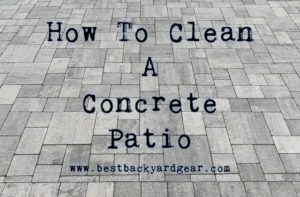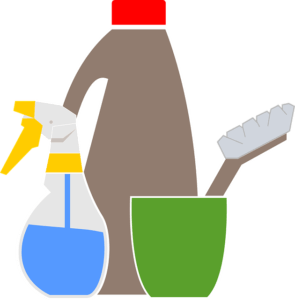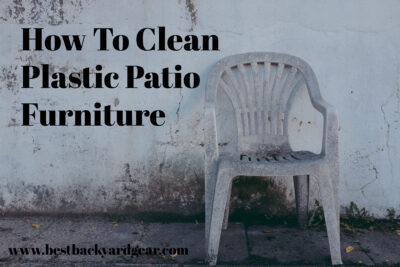 If your house has a concrete patio out back or out front, you’ll know that it can start to look pretty bad after a while if you don’t take some steps to deal with the dirt that comes from the everyday life that happens there. Today we’re going to take a look at how to clean a concrete patio.
If your house has a concrete patio out back or out front, you’ll know that it can start to look pretty bad after a while if you don’t take some steps to deal with the dirt that comes from the everyday life that happens there. Today we’re going to take a look at how to clean a concrete patio.
We’ll share some tried and true methods to making your concrete patio look new once again.
Before we get started, no matter which of the following methods you take, you’ll want to take everything off of your patio and get it out of the way. Then, sweep the concrete as clean as possible from leaves, dirt, and debris. Go ahead and have some fun with your leaf blower if you want to – make sure it’s as clean as you can get it.
Method #1: Apply A Cleanser, Scrub The Stains, Wash it off.
There are many different types of cleansers you can try, but first take a look at the type of dirt you’re dealing with.
If it’s just general grime that has built up, you can try the following:
 Cleaning Concrete With Baking Soda And Bleach: Mix a soup-like paste of baking soda and bleach (wear protective gloves and a mask, and don’t let children or pets near while you’re using the bleach), and pour over the bad spots, let sit, then scrub with a stiff brush (not steel or you may scratch the concrete), then wash off.
Cleaning Concrete With Baking Soda And Bleach: Mix a soup-like paste of baking soda and bleach (wear protective gloves and a mask, and don’t let children or pets near while you’re using the bleach), and pour over the bad spots, let sit, then scrub with a stiff brush (not steel or you may scratch the concrete), then wash off.- Mix up about spray bottle with bleach and water (1:3) and an 1/8th of a cup of liquid dishwashing detergent, spray over concrete, let sit for a few minutes, then scrub and spray off
- Cleaning Concrete With Vinegar And Baking Soda: If you don’t like the idea of bleach, slowly mix up a solution of vinegar and baking soda, pour over dirty areas, and let it do it’s thing before scrubbing and spraying off.
- Try an enzymatic cleaner such as OxiClean – mix it with some water and spray at will. Same deal… let it sit for a few minutes, then scrub and spray off.
If you’re dealing with grease stains, make paste of laundry detergent and water and let it soak in overnight (you may find covering with tarp is a good idea).
For oil stains, if you have some kitty litter, grind it in a bit and let it soak the oil up, then sweep it away – this can be a really good start at least to removing the stain.
Mildew stains can be best dealt with using a mixture of 1 part bleach, 3 parts water, and a good splash of laundry detergent. Let it soak on the stain and then before it dries, scrub it off and rinse. Of course, good old sunshine also works wonders on mildew… can you cut back some plants that may be blocking the sun from that area and let the sun shine on it?
If you live in a wet area and have problems with algae stains on your concrete, try using straight white vinegar on the problem areas, or a pool chlorine solution.
Method #2. Clean Concrete Patio With A Pressure Washer
If you have access to a good pressure washer, you’ll probably find it’s one of the easiest ways to clean a patio. You don’t have to go buy one – most tool rental centers or home improvement stores have them available to rent for the day. (Of course, you may find it a rather useful tool and want to own one.)
If you’ve never used a pressure washer before, you’ll love watching the dirt just lift away. It’s pretty awesome. Unsure how to tackle the job? Check out this super simple video:
Method #3: Dealing with Pavers (Paving Stones)
Paving stones are a beautiful way to add interest to a patio floor. There are so many interesting designs, shapes, and styles! But no matter the style, they often end up with moss or algae growing between or around them, and like a concrete slab, the stones themselves need some good cleaning off.
Start with the algae or moss. After you’ve cleared off and swept off the patio as best you can (always step 1), you have two choices; 1) Get down and work with a stiff bristled handheld brush or brush broom to work your way around the stones clearing out and pulling out the debris, or 2) Applying a vegetation killer and waiting approx 2 weeks before scraping them out.
After the stones have been cleaned around, it’s time to clean the stones themselves. Using one of the solutions above (preferably a more mild one such as warm water and dish detergent, as it will seep into the ground around each stone), pour over the stones, let soak, then scrub with a stiff bristled brush and spray off.
If you end up feeling the need to use a pressure washer due to the intensity of the dirt, do so carefully so as to not completely remove the sand between the stones (which may move the stones slightly).
You’ll likely need to refill the sand regardless of your method after cleaning. After allowing the area to dry completely, pour a small mound of polymeric sand onto the stones, and sweep the sand using a dry, stiff bristled broom all over the paved surface until the joints are filled back up. Spray a fine mist over the sand to help it settle.
If you’re interested in sealing the pavers after that to keep your clean look longer, check out this article.
Method #4: Sealing Your Concrete Patio Against Future Dirt
Perhaps you purchased your home and it came with a concrete patio – and you’re new to concrete. A tip for you: concrete can and should be regularly sealed to protect it against further soiling – on a concrete slab patio, concrete sealer rolls on like paint. Once it’s dry, you’ll have a new looking, clean concrete patio that you’ll enjoy for a long time!
A freshly cleaned concrete patio is something you’ll really enjoy, and it’s something you can take pride in. Yes, it’s a bit of work, but really worth the effort.




